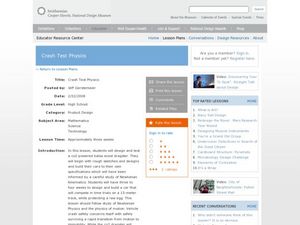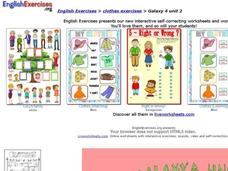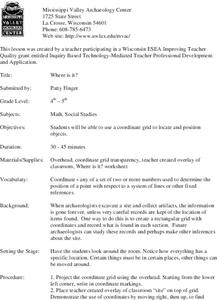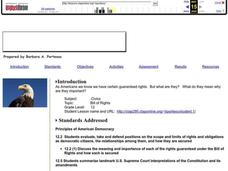Curated OER
EXPRESSIONIST ART LESSON
Sixth graders design and compose a picture that conveys a specific emotion or feeling, and recognize the use of emotion in a variety of artworks using crayons and/or pastels. They experiment and manipulate elements of art including, line...
Curated OER
Molecular Approaches to Evolution
Students examine the molecular studies of organisms that have led to a new era in their understanding of speciation and evolutionary relationships. Students study the allelic frequency of genes controlling specific molecules and assess...
Curated OER
Vanished Occupations: Life on an Iron Plantation
Learners analyze photographs to understand life on a plantation. For this vanished occupations lesson, students examine why iron plantations were created and what natural resources were needed to make iron. Learners compare the...
Curated OER
Crash Test Physics
High schoolers design and test balsa cars. In this crash tet lesson plan, students design and build their own cars to specifications. They explore the physics of motion and vehicle crash safety.
Curated OER
If I Could Have Lived in Another Time or Culture
Third graders develop multi-paragraph compositions. They include an introduction, first and second level support, and a conclusion. They use a variety of sentence structures (e.g., simple, compound/complex) and sentence types (i.e.,...
Curated OER
Self-Portrait Unit - Lesson #1
Fourth graders create self-portraits using artistic elements found in Hispanic culture and, specifically, the art of Frida Kahlo. The lesson can be adapted for any culture/country and requires an outside person with cultural knowledge.
Curated OER
Lake Effect
Fourth graders explore some of the effects Great Salt Lake has on Utah's local weather/temperature moderation, lake effect storms, and temperature inversions. They observe the differences of specific heat between soil and water and...
Curated OER
THEMATIC ESSAY
Students Compare and contrast the beliefs and methodology of three leaders of the Civil Rights movement. Using specific examples, discuss how these leaders were either successful or unsuccessful in attaining their goals.
Curated OER
Galaxy 4 Unit 2
In this clothes online interactive worksheet, students listen to a tape and write out the 6 different types of clothing they hear. Students view 8 pictures of figures wearing different types of clothing and then fill in...
Curated OER
Balance of Power
Students explore the impact of the Federal Reserve Bank. In this central bank lesson, students read specific selections out of their textbooks about the history of the bank and its role in the U.S economy. Students then select 1 of 7...
Curated OER
How Groundhog's Garden Grew
Students answer questions based on Bloom's Taxonomy after reading the book, How Groundhog's Garden Grew, by Lynne Cherry. In this reading comprehension lesson, students respond to 6 questions, one per taxonomy level, to...
Curated OER
Genocide-Holocaust
Twelfth graders gain insight and perspective as to how and why the Holocaust occured. They explain why the specific groups were targeted, and complete a brief paragraph about what it would have been like to live during this era.
Curated OER
Elected Officials in Illinois
Learners create a flow chart explaining the duties of the elected officials of the state of Illinois. They use quantum learning activities to remember specifics.
Curated OER
Civil War Battlefields
Eighth graders research a specific battle of the U.S. Civil War. Using the Internet and the Encarta Encyclopedia they conduct research, and create and publish a travel brochure that incorporates historical and visual information about...
Curated OER
Rubrics Realized
Students create a template document that contains a 6-column/6-row rubric structure. They modify their template to include scoring categories or criteria, and scoring characteristics for a specific assignment.
Curated OER
Where is it?
Students use a coordinate grid. They investigate and discuss what caused certain objects to be in specific places. They choose a room in their home to map and place objects in specific locations.
Curated OER
Class Vacation Book
Students, utilizing technology and its avenues, create, produce and publish a variety of works. They generate a bubble map to brainstorm words that describe a specific vacation spot as well as create a pattern book with graphics about...
Curated OER
Foreign Cuisine: International Foods
Students describe factors that influence one's food choices, explain how food choices reflect one's culture and ethnic background, identify ways that family members and friends may affect one's food decisions and preferences, and explain...
Curated OER
Bill of Rights
Twelfth graders list, describe, and illustrate the specific rights guaranteed to individuals and how they are secured. Then they examine landmark Supreme Court cases, such as, Airport Commissioner vs. Jews for Jesus, New Jersey vs. TLO,...
Curated OER
Long Live the Sharks and Rays
Students study shark and ray adaptations that have helped their survival. In this animal adaptations lesson students view a video and work in groups to research specific types of sharks and rays.
Curated OER
Writing Equations of Parabolas in Vertex Form
Pupils use their knowledge of the vertex form of a quadratic equation to graph parabolas using a graphing calculator, given a specific move to make. this lesson may be used as a review or as extra practice, in groups or individually.
Curated OER
Creative Dance - Element of Space
Fourth graders perform and demonstrate locomotor and non-locomotor movements, while using various dance pathways and levels, incorporating the element of space.
Curated OER
Executive Branch of the U.S. Government
Fourth graders create a K-W-L chart of what they know about the executive branch of government. They access the Internet to research a specific level of government. They create a PowerPoint presentation with a minimum of eight slides.
Curated OER
What is Framing?
Students practice framing issues. For this writing skills lesson, students participate in a classroom activity that requires them to look at specific topical issues by framing them. Students then create collages on current issues and...























